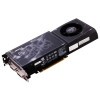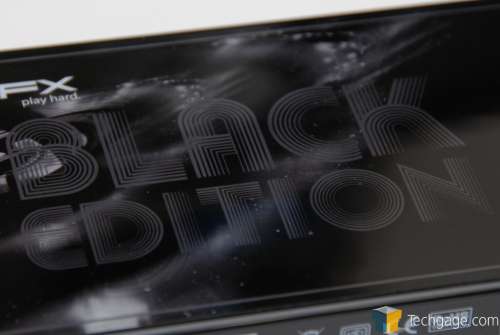- Qualcomm Launches Snapdragon 4 Gen 2 Mobile Platform
- AMD Launches Ryzen PRO 7000 Series Mobile & Desktop Platform
- Intel Launches Sleek Single-Slot Arc Pro A60 Workstation Graphics Card
- NVIDIA Announces Latest Ada Lovelace Additions: GeForce RTX 4060 Ti & RTX 4060
- Maxon Redshift With AMD Radeon GPU Rendering Support Now Available
XFX GeForce GTX 260 Black Edition

No matter your need for graphics power, the choice of GPUs right now is fantastic. Where high-end gamers are concerned, two popular options are the HD 4870 1GB and the GTX 260/216. We’re taking a look at XFX’s latest release of the latter, which features such an impressive factory overclock, it manages to keep up to the GTX 280.
Page 11 – Power Consumption, Final Thoughts
In the age where anyone can appreciate good power efficiency, it’s almost upsetting to see how much wattage any graphics card manages to pull from our walls. Even the lowest-end models don’t seem too impressive when compared to the power efficiency of a CPU, but that’s how it is, at least right now. It’s interesting to see how different GPUs compare in this regard, as some might perform better than others, but use less power, like we normally see with a shift to a smaller process node.
To help see what kind of wattage a given GPU eats on average, we use a Kill-A-Watt that’s plugged into a power bar that’s in turn plugged into one of the wall sockets, with the test system plugged directly into that. The monitor and other components are plugged into the other socket and is not connected to the Kill-A-Watt. For our system specifications, please refer to our methodology page.
Like our temperature testing, the computer is boot up and left idle for ten minutes, at which point the current wattage reading is recorded. To test for full load wattage, 3DMark Vantage is again loaded up and run at the “Extreme” setting. The space flight test is used here, with the result being recorded during a specific sequence during that run where it seems to stress the GPU the most.

We saw very small improvements in XFX’s card over the stock GTX 280 in our temperature tests, but the differences in our power efficiency tests are far more stark. Despite the fact that XFX’s overclocked card runs pretty-well just as fast as a GTX 280, it used over 30W less at full load. Oddly enough, just like the temperature tests, the idle wattage was higher, by 4W.
Final Thoughts
As I touched on in the intro to this article, it’s been quite easy lately to be caught in a trance with regards to ATI’s product line-up. They released a few killer GPUs recently and effectively took everyone’s eyes off of NVIDIA for the time-being. But, it’s cards like the GTX 260/216 that prove that NVIDIA loves a good fight.
XFX did a great job of taking things to the next level, though. Although we haven’t taken a look at the stock-clocked GTX 260 in the past, I was well-aware of what to expect performance-wise, so when the delivery guy first chucked the Black Edition at my doorstep, I already had figures floating around in my head. That was until I noticed the huge factory overclock, which as seen in our tests, works wonders.
Our results prove one important factor. XFX’s card has such a nice overclock that it actually managed to negate the fact that the GTX 280 has additional stream processors. In some cases, the Black Edition even managed to exceed the performance of the GTX 280 – something I did not expect to see.
To gage the worth of XFX’s offering, a few factors have to be looked at. Where GTX 260’s are concerned, the original models can be found online for as low as $235 after a slew of rebates, which puts it on the same level as ATI’s HD 4870, which retails for around the same price. So is another $65 worth it for the 216 model?
As usual, that’s a question you yourself have to answer, but the answer is made much easier when taking a look at XFX’s Black Edition. This card is poised to launch very soon (should have been this week, but I haven’t see it online yet), for around $300 – the same as other 216 cards. But, the Black Edition includes two notable features: Far Cry 2 and an incredible factory overclock.
Where those factors are concerned, the Black Edition is well-priced. I checked out similar cards from other manufacturers, and none were directly comparable with this one. Some had high overclocks (the closest was 650MHz Core), but didn’t include a game. The ones that did include a game, had stock or very minor factory overclocks. So when taking everything into consideration, $300 – $310 for the Black Edition turns out to be a very reasonable price.
Bottom line? If you want to save some money but still want a fantastic gaming experience, pick up an original GTX 260 or HD 4870. If you want an enhanced experience that almost matches the performance of the GTX 280 and also have the benefit of a “free” game, the Black Edition is a no-brainer. This card impressed me for multiple reasons, and I have a hard time finding a single real downside, and for that, it earns our Editor’s Choice award.
- Pros
- Performs on par with GTX 280.
- Despite a factory overclock, the card can still be pushed further.
- Great presentation; card looks great.
- Free game (Far Cry 2).
- Cons
- Since temperatures can get hot at load, custom cooler would be nice.
Discuss this article in our forums!
Have a comment you wish to make on this article? Recommendations? Criticism? Feel free to head over to our related thread and put your words to our virtual paper! There is no requirement to register in order to respond to these threads, but it sure doesn’t hurt!

XFX GeForce GTX 260 Black Edition
Support our efforts! With ad revenue at an all-time low for written websites, we're relying more than ever on reader support to help us continue putting so much effort into this type of content. You can support us by becoming a Patron, or by using our Amazon shopping affiliate links listed through our articles. Thanks for your support!






